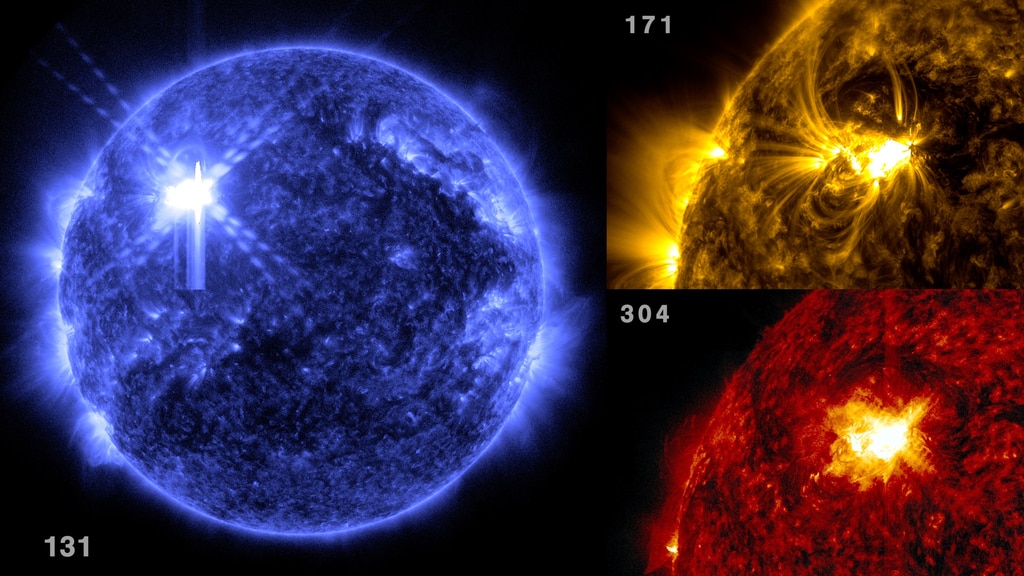Sun Emits X6.3 Flare on February 22, 2024

NASA’s Solar Dynamics Observatory captured this image of a solar flare – as seen in the bright flash on the upper left – on Feb. 22, 2024. The image shows a blend of 171 Angstrom, 193 Angstrom and 1600 Angstrom light, subsets of ultraviolet and extreme ultraviolet light. Credit: NASA/SDO
The Sun emitted a strong solar flare, peaking at 5:34 p.m. EST on Feb. 22, 2024. NASA’s Solar Dynamics Observatory, which watches the Sun constantly, captured an image of the event.
Solar flares are powerful bursts of energy. Flares and solar eruptions can impact radio communications, electric power grids, navigation signals, and pose risks to spacecraft and astronauts.
This flare is classified as an X6.3 flare. X-class denotes the most intense flares, while the number provides more information about its strength.

NASA’s Solar Dynamics Observatory captured this image of a solar flare – as seen in the bright flash on the upper left – on Feb. 22, 2024. The image shows a blend of 171 Angstrom, 131 Angstrom and 1600 Angstrom light, subsets of ultraviolet and extreme ultraviolet light. Credit: NASA/SDO

NASA’s Solar Dynamics Observatory captured this image of a solar flare – as seen in the bright flash on the upper left – on Feb. 22, 2024. The image shows a blend of 304 Angstrom and 193 Angstrom light, subsets of extreme ultraviolet light. Credit: NASA/SDO

NASA’s Solar Dynamics Observatory captured this image of a solar flare – as seen in the bright flash on the upper left – on Feb. 22, 2024. The image shows a blend of 171 Angstrom, 304 Angstrom and 193 Angstrom light, subsets of extreme ultraviolet light. Credit: NASA/SDO

NASA’s Solar Dynamics Observatory captured this image of a solar flare – as seen in the bright flash on the upper left – on Feb. 22, 2024. The image shows a blend of 171 Angstrom and 131 Angstrom light, subsets of extreme ultraviolet light that highlight the plasma loops in the corona and the extremely hot material in flares, respectively. Credit: NASA/SDO

NASA’s Solar Dynamics Observatory captured this image of a solar flare – as seen in the bright flash on the upper left – on Feb. 22, 2024. The image shows a blend of 171 Angstrom and 131 Angstrom light, subsets of extreme ultraviolet light that highlight the plasma loops in the corona and the extremely hot material in flares, respectively. Credit: NASA/SDO
NASA’s Solar Dynamics Observatory captured this imagery of a solar flare – as seen in the bright flash on the upper left – on Feb. 22, 2024. The footage shows the 193 Angstrom band of extreme ultraviolet light. Credit: NASA/SDO
NASA’s Solar Dynamics Observatory captured this imagery of a solar flare – as seen in the bright flash on the upper left – on Feb. 22, 2024. The footage shows the 131 Angstrom band of extreme ultraviolet light. Credit: NASA/SDO
NASA’s Solar Dynamics Observatory captured this imagery of a solar flare – as seen in the bright flash on the upper left – on Feb. 22, 2024. The footage shows the 171 Angstrom band of extreme ultraviolet light. Credit: NASA/SDO
NASA’s Solar Dynamics Observatory captured this imagery of a solar flare – as seen in the bright flash on the upper left – on Feb. 22, 2024. The footage shows the 1600 Angstrom band of ultraviolet light. Credit: NASA/SDO
NASA’s Solar Dynamics Observatory captured this imagery of a solar flare – as seen in the bright flash on the upper left – on Feb. 22, 2024. The footage shows the 304 Angstrom band of extreme ultraviolet light. Credit: NASA/SDO
NASA’s Solar Dynamics Observatory captured this imagery of the sunspot group responsible for the recent solar flares on Feb. 22, 2024. The footage shows HMI Continuum, which approximates the view of the Sun in visible light. Credit: NASA/SDO
For More Information
Credits
Please give credit for this item to:
NASA's Goddard Space Flight Center. However, individual items should be credited as indicated above.
-
Producer
- Scott Wiessinger (KBR Wyle Services, LLC)
Release date
This page was originally published on Friday, February 23, 2024.
This page was last updated on Friday, February 23, 2024 at 11:41 AM EST.
